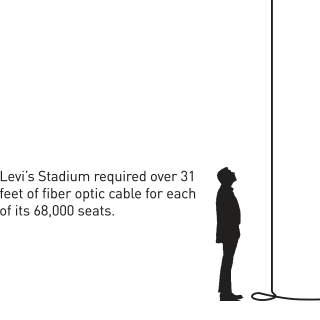New megavenues that can handle up to 250,000 fans will redefine the game-day experience. The seating area around the field won’t necessarily grow, but the arena space will extend outward to include a greater variety of ways fans can experience game day. Ballpark Village St. Louis is an early step in this evolution. Tickets will no longer be sold just for seats in view of the field; open-concept venues will provide tiers of access that allow fans to roam the complex. The tailgating experience will come inside the gates. The high-end fan will enjoy the luxury box, while the average fan brings the family to the pavilions, open at one end to the stadium bowl. These fans watch the game on massive high-definition jumbotrons from standing bar areas and picnic tables. Amusement-park rides will entertain the kids. Think of the experience as part Phoenix Open (189,000 fans per day), part Coachella music festival (75,000), part Kentucky Derby (165,000 fans), and part Disneyland.
-
01
Outdoor screen technology will continue to evolve and amaze with ever-larger and more vivid megadisplays.
-
02
Smart ticketing technology will use sports fans’ social graphs to increase the pull of live events at the stadium by connecting friends before and during games.
-
03
Self-driving vehicles will eliminate the primary inconvenience of live sporting events: parking.
-
04
Hyperloop transportation will radically increase the radius within which a trip to the game is feasible.
The world of video and connectivity is not threatening the stadium experience. Look at the way that jumbo screens have been embraced outside of venues—think Wimbledon or the World Cup. We are still human beings and we still yearn for human interaction. There is nothing more uplifting than being in a positive crowd environment with a bunch of people having fun roaring for a team. The stadium experience is no longer just in-venue.
Chris White
Vice President
Cisco Sports and Entertainment Solutions Group
Immersive interactive entertainment takes the world by storm, and virtual sports experiences leave the in-person variety in the dust. High-end micro-stadiums built to cater to the super-rich proliferate, scaling down in size and up in intimacy and luxury levels, compensating for the diminished appetite for live attendance.
Fans want to know: Am I getting content that I can’t get at home? Because if that’s the case, then that’s a benefit for me to come.
Sasha Victorine
Sporting Innovations
The future is already flooding into stadiums, thanks to fans’ handheld supercomputers, also known as smartphones:
- The Celtics and other franchises have started experimenting with seat upgrade opportunities via a mobile app for season ticket holders and offering fans video and audio programs.
- Above the Boston Bruins’ home ice at Delaware North’s TD Garden, a mobile app lets LinkedIn Lounge members know which of their professional contacts are at the game.
- The New England Patriots have promised that attendees will have access to cameras not available on TV. “You’ll be able to watch a feed from a camera that is zeroed in just on Tom Brady.” The Patriots have also hinted that fans might be able to listen in to radio communication between the coach and quarterback.
- In 2014, a cricket stadium in Australia launched LTE Advanced, a technology that broadcasts live commentary and video to fans with smartphones.
- Apps such as At the Ballpark already function as diaries of fandom. In all likelihood, when the kid of today is grown up, he will not just give his child his player cards, he’ll download a lifetime of photos and video clips of games attended — digitally enhanced and preserved memories documenting his love of the game. The lore of the game will be enhanced and personalized by deep data, encouraging fans and the children of fans to attend games to keep the tradition alive.
Stadium security will evolve, combining heightened levels of safety with tech-enhanced capabilities. Fan-generated video is already being routinely used to identify and prosecute illegal behavior by fans at games. A company called Crowdoptics has patented a system that collects information on where fans are pointing their smartphones, allowing security officials to triangulate the location of security incidents and gain immediate access to video to assess the disturbance.

Just as airports have been reconfigured with more restaurants and services inside the security zone, stadiums will extend security perimeters farther away from the field, putting more restaurants and stores inside the zone. Ticketing systems will tie together names and online IDs of ticket holders, using facial recognition technology to know exactly who is inside the security zone.
Predicting the Future
-
1-5 Years
Demand for Data Flow
-
There is no part of the in-person sports experience that won’t be radically impacted by advances in technology. Safety, security, transportation, and connection to the on-field action are all evolving. For the stadium owner, the difficult question is this: With technology advancing so quickly, how do you know where and when to place your bets? Late adopters get left behind, and, as ESPN’s recent failure with 3-D broadcasting demonstrated, early adopters often get burned.
The answer is to invest in technology that is proven but still has plenty of room for innovation. For the next five to 10 years, that technology is undoubtedly the smartphone and the growing number of connected devices. The adoption question is settled: There are now more mobile devices than there are people on the planet. However, we are just beginning to understand how they will be put to use.
Fans already expect the ability to tweet, upload pictures, view video, and access their social networks, and stadiums are working hard to keep up with the demand for data flow.
-
5-10 Years
Video Advances
-
- Video walls built into stadium architecture
- On-field holographic replays
- Glasses-free 3D technology in luxury boxes
-
10-25 Years
Urban Integration
-
Stadiums built in the future will be more modular, less expensive to build, and more multipurpose. Predicted advances in ultra-lightweight carbon fiber and other materials will allow for morphing of buildings and rooftops.
The entire footprint of the stadium area will almost certainly change with the adoption of self-driving and self-parking cars. Cars that can drop fans and then park at a distance will likely free up 20 to 30% of near-venue area for other purposes. Pre-game tailgate parties will move from the parking lot to inside the venue.
The smaller footprint of stadiums will allow them to be built closer to city centers and thereby to become more useful and more integrated in the life of a city. The entire sporting complex — not just the seats at the game — will become an attraction. Many more fans will come into the complex and while not everyone has a seat, all will have a front-row experience.




